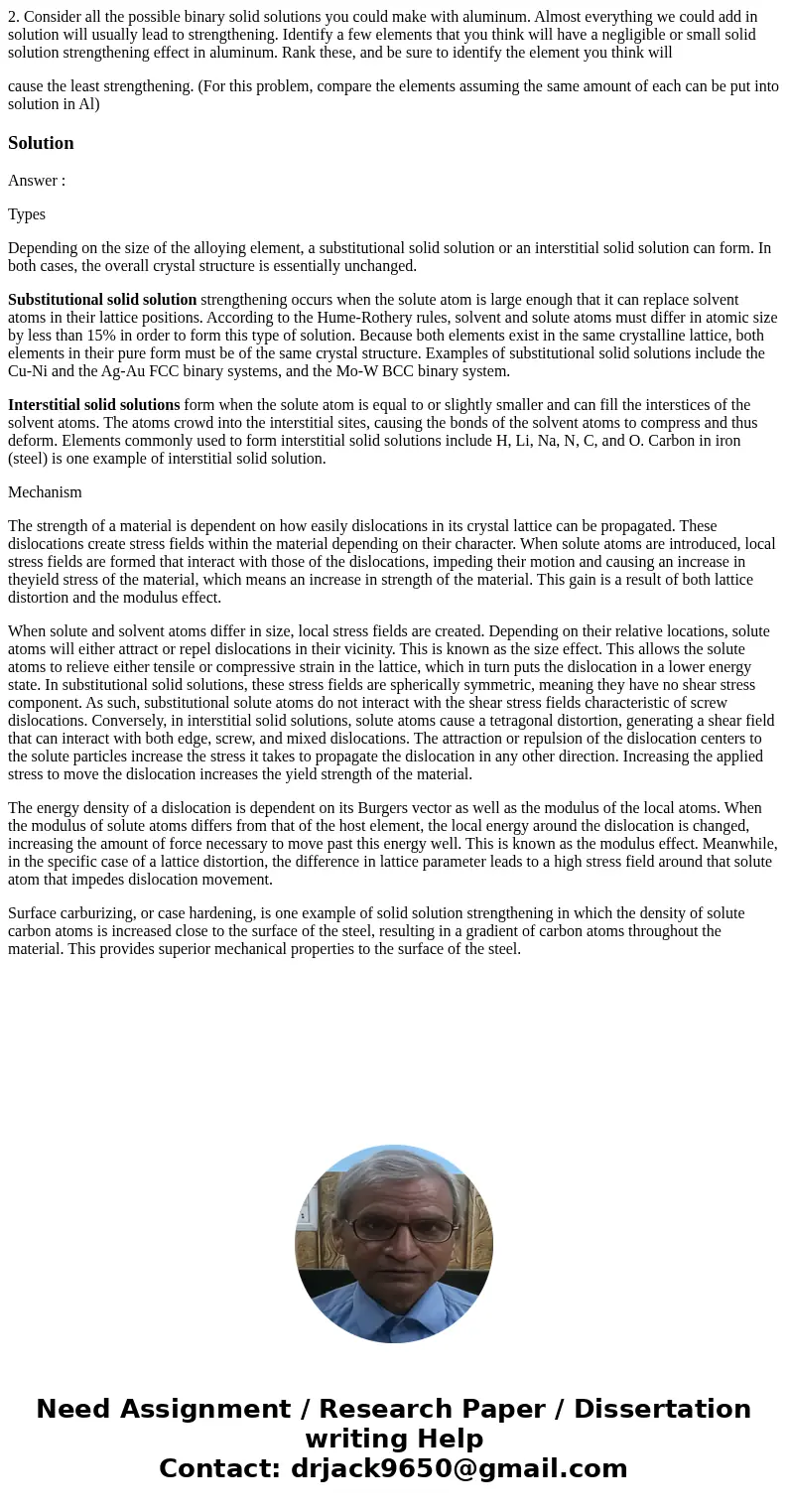2 Consider all the possible binary solid solutions you could
2. Consider all the possible binary solid solutions you could make with aluminum. Almost everything we could add in solution will usually lead to strengthening. Identify a few elements that you think will have a negligible or small solid solution strengthening effect in aluminum. Rank these, and be sure to identify the element you think will
cause the least strengthening. (For this problem, compare the elements assuming the same amount of each can be put into solution in Al)
Solution
Answer :
Types
Depending on the size of the alloying element, a substitutional solid solution or an interstitial solid solution can form. In both cases, the overall crystal structure is essentially unchanged.
Substitutional solid solution strengthening occurs when the solute atom is large enough that it can replace solvent atoms in their lattice positions. According to the Hume-Rothery rules, solvent and solute atoms must differ in atomic size by less than 15% in order to form this type of solution. Because both elements exist in the same crystalline lattice, both elements in their pure form must be of the same crystal structure. Examples of substitutional solid solutions include the Cu-Ni and the Ag-Au FCC binary systems, and the Mo-W BCC binary system.
Interstitial solid solutions form when the solute atom is equal to or slightly smaller and can fill the interstices of the solvent atoms. The atoms crowd into the interstitial sites, causing the bonds of the solvent atoms to compress and thus deform. Elements commonly used to form interstitial solid solutions include H, Li, Na, N, C, and O. Carbon in iron (steel) is one example of interstitial solid solution.
Mechanism
The strength of a material is dependent on how easily dislocations in its crystal lattice can be propagated. These dislocations create stress fields within the material depending on their character. When solute atoms are introduced, local stress fields are formed that interact with those of the dislocations, impeding their motion and causing an increase in theyield stress of the material, which means an increase in strength of the material. This gain is a result of both lattice distortion and the modulus effect.
When solute and solvent atoms differ in size, local stress fields are created. Depending on their relative locations, solute atoms will either attract or repel dislocations in their vicinity. This is known as the size effect. This allows the solute atoms to relieve either tensile or compressive strain in the lattice, which in turn puts the dislocation in a lower energy state. In substitutional solid solutions, these stress fields are spherically symmetric, meaning they have no shear stress component. As such, substitutional solute atoms do not interact with the shear stress fields characteristic of screw dislocations. Conversely, in interstitial solid solutions, solute atoms cause a tetragonal distortion, generating a shear field that can interact with both edge, screw, and mixed dislocations. The attraction or repulsion of the dislocation centers to the solute particles increase the stress it takes to propagate the dislocation in any other direction. Increasing the applied stress to move the dislocation increases the yield strength of the material.
The energy density of a dislocation is dependent on its Burgers vector as well as the modulus of the local atoms. When the modulus of solute atoms differs from that of the host element, the local energy around the dislocation is changed, increasing the amount of force necessary to move past this energy well. This is known as the modulus effect. Meanwhile, in the specific case of a lattice distortion, the difference in lattice parameter leads to a high stress field around that solute atom that impedes dislocation movement.
Surface carburizing, or case hardening, is one example of solid solution strengthening in which the density of solute carbon atoms is increased close to the surface of the steel, resulting in a gradient of carbon atoms throughout the material. This provides superior mechanical properties to the surface of the steel.

 Homework Sourse
Homework Sourse